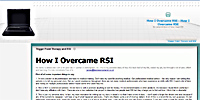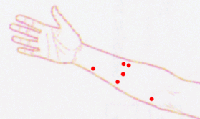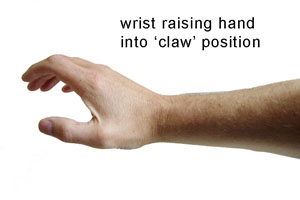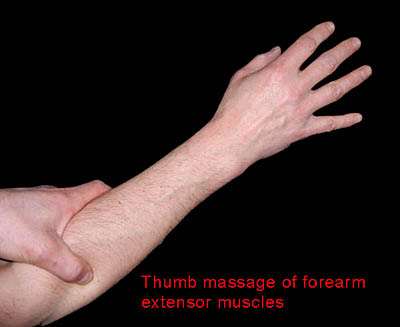 OK, time for a progress report on trigger point therapy, its been six weeks since I started to do some trigger point massage. Have I seen some improvements? Yes. Has my RSI pain improved? Yes! Has my RSI gone? Not yet!
OK, time for a progress report on trigger point therapy, its been six weeks since I started to do some trigger point massage. Have I seen some improvements? Yes. Has my RSI pain improved? Yes! Has my RSI gone? Not yet!
Trigger point therapy, as discussed previously in my post “Does forearm extensor trigger point massage offer a potential cure for RSI?”, is a method of massaging trigger points (muscle knots) that refer their pain elsewhere eg forearm extensors into hands and fingers.
Before starting Trigger Point Massage it is essential to understand the anatomy of the forearm muscles and what they do, where they form muscle knots and where they refer pain to, and as discussed in a previous post, the Trigger Point Therapy Workbook is a great place to start with this understanding.
Weeks 1/2
The first two weeks were mainly spent in a lot of pain, easily finding extremely sore trigger point muscles of the forearm extensor groups. I had exceptionally sore areas in the Extensor Carpal Radialis Longus, Extensor Carpal Radialus Brevis and the Extensor Digitorum. Couldn’t find anything going on in the Extensor Indicis despite having had a history of index finger overuse and pain previously.
Massage was done mainly by supported thumb, and knuckles, 3-4 times a day. Excruciating pain was experienced during massage from many of these trigger point areas, and as such can lead to a reluctance to continue, however I just had to keep saying to myself “this muscle is sore and it shouldn’t be”, grit my teeth and keep massaging!
Most of this period was spent in continual pain from the massage. It is a recurring theme with trigger point massage. Your arms spend a large portion of time in pain from the massage as well as the RSI condition. So there is very little opportunity to asses any progress. I reckoned, however, that if I am massaging sore tissue then that must be a good thing!
Weeks 3/4
As the sore extensor muscles recovered from their intensive massaging of the previous weeks, the forearm felt less painful, but it was a gradual process. Sometimes taking a day or two off of massage treatments helps, just to give the arms time to recover and to allow you to assess progress. I had massaged out the eye-wateringly sore extensors, but there was some deeper down trigger points in lower muscle tissues to try to access, as well as a persistent ache at the point where the extensors attach to the elbow. I also found a sore trigger point in my Extensor Carpi Ulnaris, which I subsequently found massaging can lead to a nerve type pain down the outer edge of the hand wrist and little finger, which wasn’t good, and is something to be wary of. If you are trying trigger point therapy yourself, please be careful not to massage nerves!
I have used my thumb for massaging, but as stated in the Trigger Point Therapy Workbook, extended use of heavy pressure with the thumbs alone can lead to sore thumbs pretty quickly and as such is not advised. The book recommends the use of balls eg tennis balls (or denser rubber ones) to roll your arm muscles against beside a wall. They also recommend a ‘Knobble’ which is a hardish object that you can grip with a knobbly protrusion which can be used as a pressure point for massage. I have generally just used my hands (knuckles and supported thumb) and a beach pebble (with smooth rounded edges) for massage through a fleece top, and both have worked quite well, although its very tempting to resort to using the thumbs which really should be avoided!
Weeks 5/6
After massaging out most of the extensor trigger point (muscle knots), I still have sensitive tissue areas around the elbow where the extensors attach, and this area is still being worked on. After a suggestion from James of How I Overcame RSI I also checked the inner forearm muscle called the Brachioradialis which is a muscle on the inner side of the arm that attaches to the lower end of the upper arm, and is used to bend the elbow. Under this is a smaller muscle called the Supinator which turns the hand palm side up. Much to my surprise, I found trigger points in both of these especially at the points close to the elbow/lower upper arm. The book suggests that trigger points here can refer pain to the thumb area as well as the inner forearm, but James also indicated that in his experience they also referred pain to much of the forearm too. I also found a small trigger point on the Brachialis (bicep) of the right arm, and have massaged it too. The Trigger Point Therapy book says that this point can refer pain to the thumb.
Progress
Progress is actually a difficult thing to asses on an ongoing basis. As I have mentioned before this is because you are in quite a lot of pain from the massage for a large part of trigger point therapy. You literally spend a lot of time massaging, and even after the sorest muscles are less sore, there are still a lot of aches around and you are still stressing the forearm muscles with massage. The only real way to assess progress is to take a two/three day halt in proceedings, and see how they are. I’ve done this a couple of times, and yes the arm muscle pain of RSI does seem to be improving, it’s just not gone yet!
I am, however, very encouraged by the less screamingly sore muscles in my forearms, and am tending to focus on secondary areas now. I still feel pain from typing and mouse use, but much less intense than before, which must be a good thing. How sore the pain would be after a more demanding day of computer use is another question altogether though!
There are also other potential areas according to the Trigger Point Workbook that can refer pain to the arms and hands, including the Scalenes (shoulder neck area) and Triceps (back of upper arms), so more investigation of these areas for trigger points is required. I also am doing a lot of deep probing of the forearm extensors and finding a lot of trigger points down there, which are very hard to reach and even harder to massage on a continual basis. Some of these small painful muscle fibres appear to be narrower than a fingers width and as soon as you get a finger on them to do massage they disappear to the left or right of your massaging finger before you get the opportunity to truly massage them, very frustrating!
I should also add in that I am doing some wrist rotations to work the extensor muscles in a fluid motion using a weight of about 1kg, and am also doing some work with a Powerball in slow motion.
I will continue to update on my progress here as therapy progresses, although I am at this stage very encouraged by Trigger Point Therapy as a potential solution!



 The common position for hands hovering above a keyboard is as shown on the right, which I refer to as the ‘claw’. This position elevates the tension in the aforementioned extensor muscles, causing them to become fatigued over prolonged periods of time. Typing whilst the hand/wrists are in this position (another common posture mistake) will further
The common position for hands hovering above a keyboard is as shown on the right, which I refer to as the ‘claw’. This position elevates the tension in the aforementioned extensor muscles, causing them to become fatigued over prolonged periods of time. Typing whilst the hand/wrists are in this position (another common posture mistake) will further 
